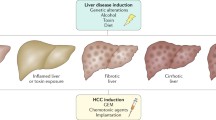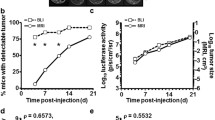Abstract
Hepatocellular carcinoma (HCC) is one of the most serious health problems worldwide. Many researchers have investigated HCC at the level of genes, ribonucleic acid, proteins, cells, and animals. The resultant development of animal models and monitoring methods has improved the effectiveness of guidelines provided to researchers working with preclinical HCC models. HCC in animal models and clinical patients is monitored by various current imaging modalities such as ultrasound (US) imaging, computed tomography (CT), magnetic resonance imaging (MRI), single photon emission computed tomography (SPECT), positron emission tomography (PET) and bioluminescence imaging (BLI). These techniques are currently used for both preclinical and clinical assessment, and provide valuable diagnostic information. In this article, we have mainly reviewed the established animal models and the assessment of orthotopic HCC using imaging modalities. Additionally, we have introduced a method of orthotopic HCC rat model developed in our laboratory. We have furthermore evaluated the occurrence of tumor mass using molecular imaging techniques.



Similar content being viewed by others
References
World Health Organization. Liver Cancer Estimated Incidence, Mortality and Prevalence Worldwide in 2012. International Agency for Research on Cancer. 2012. http://globocan.iarc.fr/Pages/fact_sheets_cancer.aspx. Accessed 13 Mar 2014.
Siegel R, Naishadham D, Jemal A. Cancer Statistics, 2012. CA Cancer J Clin. 2012;62:10–29.
Siegel R, Naishadham D, Jemal A. Cancer Statistics, 2013. CA Cancer J Clin. 2013;63:11–30.
Siegel R, Ma J, Zou Z, Jemal A. Cancer Statistics, 2014. CA Cancer J Clin. 2014;64:9–29.
Ruiz J, Mazzolini G, Sangro B, Qian C, Prieto J. Gene Therapy of Hepatocellular Carcinoma. Dig Dis. 2001;19:324–32.
Wong SY, Hann HW. Hepatitis B related hepatocellular carcinoma. OA Hepatology. 2013;1(1):7–22.
Xu C, Zhou W, Wang Y, Qiao L. Hepatitis B virus-induced hepatocellular carcinoma. Cancer Lett. 2014;345(2):216–22.
Anderson SC, Johnson DE, Harris MP, et al. p53 gene therapy in a rat model of hepatocellular carcinoma. Clin Cancer Res. 1998;4:1649–59.
Tang ZY. Hepatocellular carcinoma-cause, treatment and metastasis. World J Gastroenterol. 2001;7(4):445–54.
Kim KI, Lee YJ, Lee TS, Song I, Cheon GJ, Lim SM, et al. In vitro radionuclide therapy and in vivo scintigraphic imaging of alpha-fetoprotein-producing hepatocellular carcinoma by targeted sodium iodide symporter gene expression. Nucl Med Mol Imaging. 2013;47:1–8.
Quagliata L, Matter MS, Piscuoglio S, Arabi L, Ruiz C, Procino A, et al. Long noncoding RNA HOTTIP/HOXA13 expression is associated with disease progression and predicts outcome in hepatocellular carcinoma patients. Hepatology. 2014;59(3):911–23.
Tai WT, Shiau CW, Chen PJ, Chu PY, Huang HP, Liu CY, et al. Discovery of novel Src homology region 2 domain-containing phosphatase 1 agonists from sorafenib for the treatment of hepatocellular carcinoma. Hepatology. 2014;59(1):190–201.
Peng YF, Shi YH, Ding ZB, Ke AW, Gu CY, Hui B, et al. Autophagy inhibition suppresses pulmonary metastasis of HCC in mice via impairing anoikis resistance and colonization of HCC cells. Autophagy. 2013;9(12):2056–68.
Huynh H, Ong R, Soo KC. Foretinib demonstrates anti-tumor activity and improves overall survival in preclinical models of hepatocellular carcinoma. Angiogenesis. 2012;15(1):59–70.
Chae MJ, Lee ST, Kim JY, Woo GS, Jung WS, Chun KS, et al. Small animal PET imaging with [124I]FIAU for herpes simplex virus type 1 thymidine kinase gene expression in a hepatoma model. Nucl Med Mol Imaging. 2008;42(3):235–45.
Lin CY, Chen JH, Liang JA, Lin CC, Jeng LB, Kao CH. 18F-FDG PET or PET/CT for detecting extrahepatic metastases or recurrent hepatocellular carcinoma: a systematic review and meta-analysis. Eur J Radiol. 2012;81(9):2417–22.
Addley HC, Griffin N, Shaw AS, Mannelli L, Parker RA, Aitken S, et al. Accuracy of hepatocellular carcinoma detection on multidetector CT in a transplant liver population with explant liver correlation. Clin Radiol. 2011;66(4):349–56.
Ma X, Liu Z, Yang X, Gao Q, Zhu S, Qin C, et al. Dual-modality monitoring of tumor response to cyclophosphamide therapy in mice with bioluminescence imaging and small-animal positron emission tomography. Mol Imaging. 2011;10(4):278–83.
Thompson SM, Callstrom MR, Knudsen B, Anderson JL, Butters KA, Grande JP, et al. AS30D model of hepatocellular carcinoma: tumorigenicity and preliminary characterization by imaging, histopathology, and immunohistochemistry. Cardiovasc Intervent Radiol. 2013;36(1):198–203.
Schmitz V, Tirado-Ledo L, Tiemann K, Raskopf E, Heinicke T, Ziske C, et al. Establishment of an orthotopic tumour model for hepatocellular carcinoma and non-invasive in vivo tumour imaging by high resolution ultrasound in mice. J Hepatol. 2004;40(5):787–91.
Li Y, Tang ZY, Ye SL, Liu YK, Chen J, Xue Q, et al. Establishment of cell clones with different metastatic potential from the metastatic hepatocellular carcinoma cell line MHCC97. World J Gastroenterol. 2001;7(5):630–6.
Armengol C, Tarafa G, Boix L, Solé M, Queralt R, Costa D, et al. Orthotopic implantation of human hepatocellular carcinoma in mice: analysis of tumor progression and establishment of the BCLC-9 cell line. Clin Cancer Res. 2004;10(6):2150–7.
Lin HL, Lui WY, Liu TY, Chi CW. Reversal of Taxol resistance in hepatoma by cyclosporin A: involvement of the PI-3 kinase-AKT 1 pathway. Br J Cancer. 2003;88(6):973–80.
Lee TK, Lau TC, Ng IO. Doxorubicin-induced apoptosis and chemosensitivity in hepatoma cell lines. Cancer Chemother Pharmacol. 2002;49(1):78–86.
Yao X, Hu JF, Daniels M, et al. A novel orthotopic tumor model to study growth factors and oncogenes in hepatocarcinogenesis. Clin Cancer Res. 2003;9:2719–26.
Ma SH, Chen GG, Yip J, Lai PB. Therapeutic effect of alpha-fetoprotein promoter-mediated tBid and chemotherapeutic agents on orthotopic liver tumor in mice. Gene Ther. 2010;17(7):905–12.
Vongchan P, Kothan S, Wutti-In Y, Linhardt RJ. Inhibition of human tumor xenograft growth in nude mice by a novel monoclonal anti-HSPG isolated from human liver. Anticancer Res. 2011;31(12):4067–74.
Chandra PK, Kundu AK, Hazari S, Chandra S, Bao L, Ooms T, et al. Inhibition of hepatitis C virus replication by intracellular delivery of multiple siRNAs by nanosomes. Mol Ther. 2012;20(9):1724–36.
Cho HR, Choi JW, Kim HC, Song YS, Kim GM, Son KR, et al. Sprague-Dawley rats bearing McA-RH7777 cells for study of hepatoma and transarterial chemoembolization. Anticancer Res. 2013;33(1):223–30.
Buijs M, Geschwind JF, Syed LH, Ganapathy-Kanniappan S, Kunjithapatham R, Wijlemans JW, et al. Spontaneous tumor regression in a syngeneic rat model of liver cancer: implications for survival studies. J Vasc Interv Radiol. 2012;23(12):1685–91.
Wu SD, Ma YS, Fang Y, Liu LL, Fu D, Shen XZ. Role of the microenvironment in hepatocellular carcinoma development and progression. Cancer Treat Rev. 2012;38(3):218–25.
Lee HJ, Choi HJ, Yang HM, Kim YM, Lee J, Chio D, et al. Establishment of primary xenograft model from newly characterized patient extrauterine carcinosarcoma. Int J Gynecol Cancer. 2013;23(9):1552–60.
Wang Q, Luan W, Goz V, Burakoff SJ, Hiotis SP. Non-invasive in vivo imaging for liver tumour progression using an orthotopic hepatocellular carcinoma model in immunocompetent mice. Liver Int. 2011;31(8):1200–8.
Walters DM, Stokes JB, Adair SJ. Stelow EB. Lowrey BT, et al. Clinical, molecular and genetic validation of a murine orthotopic xenograft model of pancreatic adenocarcinoma using fresh human specimens. PLoS ONE. 2013;8(10):e77065.
Lu W, Melancon MP, Xiong C, Huang Q, Elliott A, Song S, et al. Effects of photoacoustic imaging and photothermal ablation therapy mediated by targeted hollow gold nanospheres in an orthotopic mouse xenograft model of glioma. Cancer Res. 2011;71(19):6116–21.
Oliva MR, Saini S. Liver cancer imaging: role of CT. US and PET. Cancer Imaging. 2004;4(Spec No A):S42-6.
Cheung TT, Fan ST, Chan SC, Chok KS, Chu FS, Jenkins CR, et al. High-intensity focused ultrasound ablation: an effective bridging therapy for hepatocellular carcinoma patients. World J Gastroenterol. 2013;19(20):3083–9.
Wintermark M, Sesay M, Barbier E, Borbély K, Dillon WP, Eastwood JD, et al. Comparative overview of brain perfusion imaging techniques. J Neuroradiol. 2005;32(5):294–314.
Sarraf-Yazdi S, Mi J, Dewhirst MW, Clary BM. Use of in vivo bioluminescence imaging to predict hepatic tumor burden in mice. J Surg Res. 2004;120(2):249–55.
Zheng J, Xu L, Zhou H, Zhang W, Chen Z. Quantitative analysis of cell tracing by in vivo imaging system. J Huazhong Univ Sci Technol Med Sci. 2010;30(4):541–5.
Pino-Lagos K, Michea P, Sauma D, Alba A, Morales J, Bono MR, et al. Cyclosporin A-treated dendritic cells may affect the outcome of organ transplantation by decreasing CD4 + CD25+ regulatory T cell proliferation. Biol Res. 2010;43(3):333–7.
Rogosheske JR, Fargen AD, DeFor TE, Warlick E, Arora M, Blazar BR, et al. Higher therapeutic CsA levels early post transplantation reduce risk of acute GVHD and improves survival. Bone Marrow Transplant. 2014;49(1):122–5.
Hamdy S, Haddadi A, Shayeganpour A, Alshamsan A, Montazeri Aliabadi H, Lavasanifar A. The immunosuppressive activity of polymeric micellar formulation of cyclosporine A: in vitro and in vivo studies. AAPS J. 2011;13(2):159–68.
Hammond-McKibben D, Lake P, Zhang J, Tart-Risher N, Hugo R, Weetall M. A high-capacity quantitative mouse model of drug-mediated immunosuppression based on rejection of an allogeneic subcutaneous tumor. J Pharmacol Exp Ther. 2001;297(3):1144–51.
Van de Vrie W, Marquet RL, Eggermont AM. Cyclosporin A enhances locoregional metastasis of the CC531 rat colon tumour. J Cancer Res Clin Oncol. 1997;123(1):21–4.
Acknowledgments
This study was supported by Radiation Technology R&D programs through the National Research Foundation of Korea Grant (NRFG) funded by the Ministry of Education, Science and Technology (2012-M2A2A7014020, 2011-0028581).
Conflict of Interest
Tai Kyoung Lee, Kyung Sook Na, Jeonghun Kim and Hwan-Jeong Jeong declare that they have no conflict of interest.
Ethical Statement
This study was approved by the animal ethics committee in our hospital and performed in accordance with the ethical standards laid down in the 1964 Declaration of Helsinki and its later amendments.
Author information
Authors and Affiliations
Corresponding author
Rights and permissions
About this article
Cite this article
Lee, T.K., Na, K.S., Kim, J. et al. Establishment of Animal Models with Orthotopic Hepatocellular Carcinoma. Nucl Med Mol Imaging 48, 173–179 (2014). https://doi.org/10.1007/s13139-014-0288-y
Received:
Revised:
Accepted:
Published:
Issue Date:
DOI: https://doi.org/10.1007/s13139-014-0288-y




